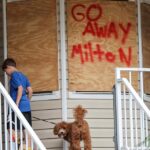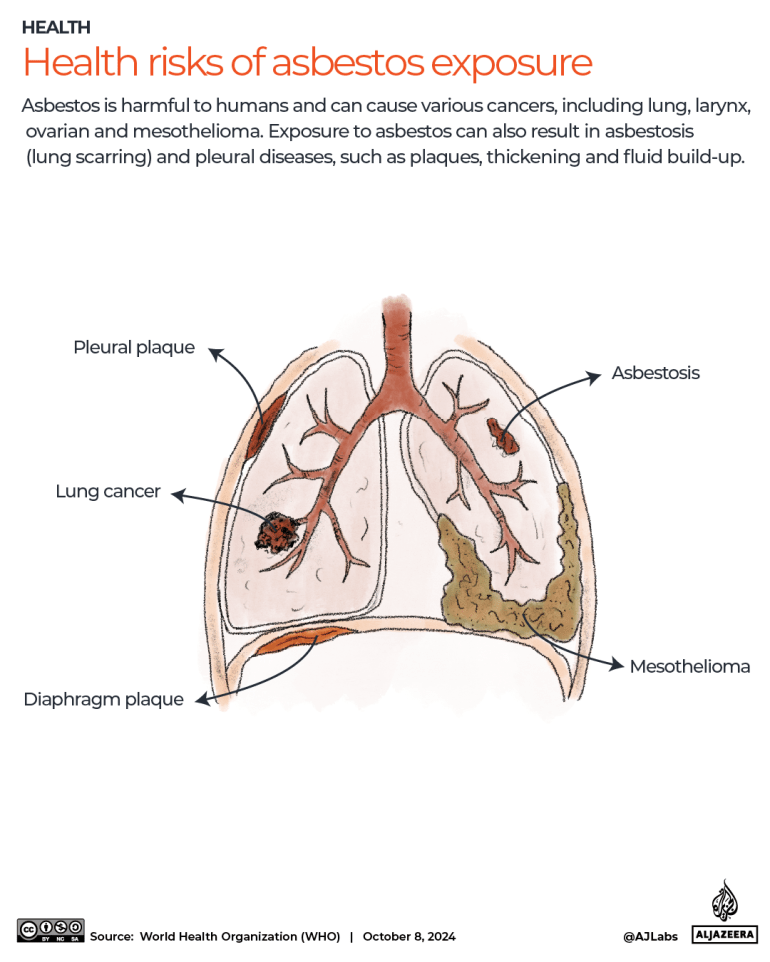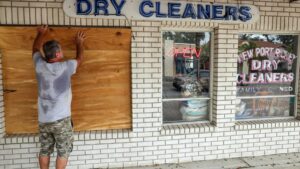Israel’s relentless bombardment of Gaza has unleashed yet another deadly, but silent enemy on the people there – asbestos.
A mineral that poses little risk to humans when undisturbed but that is highly carcinogenic when dispersed and released into the atmosphere, asbestos is present throughout much of Gaza’s structures.
Over the past year, Israel’s bombs have caused vast amounts of it to be broken into tiny, airborne particles, which can potentially cause cancer in those who breathe it in, leading experts to say cases of cancer will likely be reported “for decades” in Gaza.
According to United Nations estimates, some 800,000 tonnes of the bombed-out debris across Gaza may be contaminated with asbestos.
This is a “death sentence” for Palestinians trapped in Gaza, leading asbestos expert Roger Willey told Al Jazeera.
‘A tragedy that will unfold in the years ahead’
The asbestos exposure of people caught in the aftermath of each of Israel’s bombing raids can be compared to that around the World Trade Center when it collapsed in New York City on September 11, 2001, Willey said.
Years later, it became apparent that toxic chemicals, including asbestos, were in the dust clouds.
“I made a prediction then [in 2001] that more people would die from the asbestos-related diseases than were killed in the September 11 attacks,” Willey said.

According to the World Trade Center Health Program, 4,343 survivors and first responders have died from related illnesses since the attack compared to the 2,974 people who died on September 11.
“It’s going to be exactly the same in Gaza,” Willey continued.
“[A]irborne concentrations [of asbestos] … will be enormously high, and that is guaranteed mesothelioma,” Willey said, referring to a cancer that commonly forms in the lining around the lungs or abdomen.
Asbestos exposure can also result in cancers of the lung, larynx and ovaries as well as asbestosis, which the US National Cancer Institute describes as an “inflammatory condition affecting the lungs that can cause shortness of breath, coughing and permanent lung damage”.
Marcy Borders, pictured below, survived the WTC attack and was considered lucky to be alive. But it can take decades for asbestos-related cancers to emerge.

The Dust Lady died of stomach cancer in 2015.
“The rescue crews on September 11 … were exposed to asbestos particles for 10 to 12 hours before continuing the next day,” Willey said.
“That’s a death sentence… that’s going to be the same for the people in Gaza.”
The comparison to September 11 is important as that was one of the only incidents in which it was possible to study asbestos exposure after an explosion, said Liz Darlison, CEO of the charity Mesothelioma UK.
“It’s very easy to be preoccupied with the immediate aftermath” of the destruction, she said.
Immediate dangers posed by ground fighting and aerial bombardments always take precedence over long-term hazards, she noted.
However, the long-term effects of asbestos exposure will constitute a “tragedy that will unfold in the years ahead”, Darlison said.
In 2016, the United Nations Environment Programme (UNEP) said occupational asbestos exposure had caused an estimated 209,481 deaths – more than 70 percent of all deaths from work-related cancers.
Ubiquitous asbestos, in the refugee camps
Due to its insulating and fireproofing qualities, asbestos was widely used in construction until the late 1980s, when countries worldwide, including Israel, began introducing restrictions. Israel fully banned the use of asbestos in buildings in 2011.
Since its war on the besieged enclave began, Israel has routinely bombed Gaza’s refugee camps where, UNEP told Al Jazeera, asbestos was found “in the older buildings and temporary sheds and extensions found in the refugee camps”.

In December, 90 people were killed and more than 100 injured in an attack on Jabalia refugee camp in northern Gaza.
In June, Israel killed more than 270 Palestinians and injured around 700 others in a raid on Nuseirat refugee camp.
In 2009, UNEP said it found one of the most dangerous types of asbestos, blue asbestos (crocidolite), in the same damaged buildings and sheds in the refugee camps of Gaza, as well as in sewage pipes, treatment stations and livestock facilities.
No escape, no ‘safe’ level of exposure
The best thing to do if asbestos is disturbed and becomes airborne is to “get in a car and drive as far away from it as possible”, Willey said.
A solution that is simply not possible for the more than two million Palestinians crammed in the enclave of about 365 square kilometres (141sq miles) of which, the UN has warned, only 11 percent remains considered a safe zone.

Furthermore, adequate clean-up processes can take years and must be carried out by professionals, Willey said.
In Gaza now, he said: “You’ve got smashed asbestos pieces on the ground, in the air from the explosion, and people are walking through it and kicking it up all the time, so it’ll never come back to a safe environment until it’s all cleared away”.
Darlison said after an explosion that releases asbestos, there would simply be no “safe level of exposure”.
“What you need is a big sign with a skull and crossbones saying ‘Do not enter’, and only specialists wearing full decontamination equipment allowed near the exposure,” she said.
Acutely aware of the damage asbestos can cause, Darlison said she “cannot bear” to watch the smoke billowing from the explosions in Gaza.
“It’s heartbreaking to know that the legacy of this war will continue for many years,” she said.










More Stories
1 injured in Tuesday morning crash in Brighton
What to know about Hurricane Milton as it moves toward Florida’s Gulf Coast
Nearly 200 arrests made in street racing bust